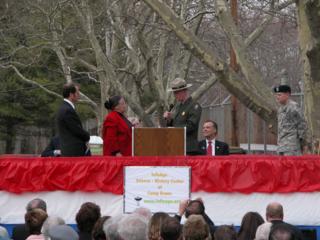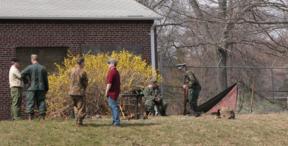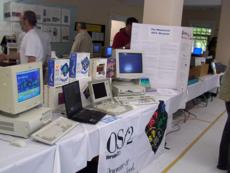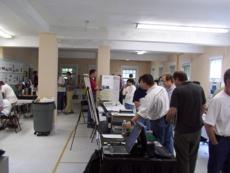

Active GUI element
Static GUI element
Code
WPS object
File/Path
Command line
Entry-field content
[Key combination]
OS/2 Museum at VCF East
Mark Dodel is the founding editor of the VOICE Newsletter and is the current moderator of the VOICE News mailing list http://www.os2voice.org. Mark is a past president of Warpstock, the annual OS/2-eComStation user conference in North America and continues as an advisor to the board of directors of Warpstock, Inc. He has worked for many years as a computer comsultant for clinical hospital systems development.
If you made it to Warpstock in Hershey, Pennsylvania last year, you had a chance to see the nucleus of a collection of vintage OS/2 machines and software which we called the Warpstock OS/2 Museum. It was great to see some of the equipment I had worked with in the past as well as some things like OS/2 Power PC edition and OS/2 1.0 which I had never seen before. The question came up as to what to do with these items after Warpstock was over. For a few months the boxes resided in my basement, garage and crawl space. That was a less than satisfactory solution since I wanted people to view the collection and hopefully expand it with more contributions in the future.
InfoAge, a brand new Science-History Center
Fig. 1. Turnover of Fort Evans to InfoAge [Larger image]
While looking around for a location that could not only house the collection, but make it available to anyone who would be interested in seeing it, I found a brand new computer museum that was still in the early stages of formation near the Atlantic coast in the town of Wall, New Jersey. Not exactly close to where I live, but still drivable. Best of all they were not only interested in providing a home for the collection, but were extremely open to letting the items be exhibited at future Warpstock events. Evan Koblentz, the President of MARCH (The Mid-Atlantic Retro Computing Hobbyists), filled me in on the plans for their group to join with other groups in developing a decommissioned military base (Camp Evans) into a Science-History Center supported by state and private funding. I attended the ceremony turning over the base from the military to its new owners, an organization called InfoAge, this past March. The site needs a lot of work but there are a number of dedicated volunteers from MARCH, and other associated groups, who are putting a lot of hours into renovating all the old Army buildings. I wish I were closer and could help.
Fig. 2. Military reenactors [Larger image]
I took most of the OS/2 Museum items that we had collected to that point that I could fit in my van, for storage at the InfoAge site when I went to the turnover ceremony. This included a lot of OS/2 related magazines and documentation as well as most of the computers and software that we had at Hershey. My guess is the site won't be open as a computer museum until sometime next year, but some of the other groups, like the ham radio guys and the model railroaders, are further along with their buildings. Besides the ceremony they had a number of WWII military reenactors including a few guys dressed in German uniforms (see figure 2) and a few in U.S. Civil War uniforms as well. It was a beautiful day with high hopes for the future.
Vintage Computer Festival - East 3.0
Fig. 3. VCF East 3.0, OS/2 Museum exhibit [Larger image] (Photo courtesy of Andy Meyer)
One of the first events to be held in the still not quite completed main building was the VCFE (Vintage Computer Festival East). The big day was May 13th [2006] and I had made plans to display some of our Warpstock OS/2 Museum collection, registering for a table in the exhibit area. I loaded up my car on Friday so I'd be all set to leave early on Saturday. I was not quite sure of what kind of reaction all this OS/2 stuff would get from the crowd the next day.
The drive across Jersey was uneventful and I arrived at the InfoAge site at 7:30AM just as they were letting exhibitors setup. I only had one table, right in the middle of the exhibit area, so I only put out 4 machines - the PS/2 Model 50Z running OS/2 1.0EE, the Power Series PC model 830 with OS/2 Power PC edition, a PS/2 L40SX laptop running OS/2 2.0, and my IBM Thinkpad T42p running eComStation 1.2MR. That last one just to show that OS/2 is still alive and running on some fairly recent hardware. To keep on topic with the vintage computing theme I had Stardock's Galactic Civilization running on my T42p.
And to help educate people about the history of OS/2, I
had made up a trifold display board with a time line of all versions of OS/2 and
eComStation on it and information about Warpstock. In addition I brought along my portable DVD player to show the
NT versus OS/2 Shootout in Texas
video. This was the unedited version that included Doug Davis'
(Microsoft's presenter) somewhat inept demonstration of Windows NT, and David Barnes' (IBM's presenter)
superb performance showing off the then state-of-the-art OS/2 2.1. The NT part was so pathetic that Microsoft
demanded that their part of the final video be removed.
Fig. 4. VCFE 3.0 Exhibit area [Larger image] (Photo courtesy of Andy Meyer)
I haven't seen final attendance figures but Evan told me they had about 100 paying attendees plus 18 exhibitors and several volunteers. People drifted in and out all day but it was the most crowded around noon. From what I saw the overall crowd was younger then we get at Warpstock, with a few people bringing their kids. There were a few college age as well. Most of the people I spoke with were from the East coast, which makes sense since there is both a West and East coast annual Vintage Computer event. Although I talked to people who drove from Ohio and there was one guy there from Holland. Only a handful people picked up the Warpstock flyer I had printed, but quite a few people stopping at the exhibit mentioned they remembered OS/2 fondly and a few said they still run it. One person thought IBM had dropped OS/2 years ago and was surprised that it was still around. A few even knew about eComStation. A couple of guys offered some old PS/2s and monitors for the collection. Hopefully I'll hear from them as we can definitely use a few more PS/2s and monitors for some of the older versions of OS/2 we have collected.
The rest of the show
There was a lot of stuff to see and the crowd seemed pretty happy with all of it. There were only 5 lecture sessions during the whole day in one room that held maybe 50-60 people. The topics were mostly on computer history. One of the speakers gave a session on ARPA (the original developer of the Internet). I missed all but one of the lectures because I stayed in the exhibit area which had people in it throughout the whole day. The only presenter I was familiar with was David Ahl who had started Creative Computing magazine back in the early-mid 70s. His session covered early computer history (Turing through the 70s). Mr. Ahl auctioned a set of the first 13 issues of his magazine, Creative Computing, and a BASIC programming computer book with all the proceeds going to charity.
There was a lot to see in the exhibit area with 17 exhibitors besides our OS/2 Museum table. I didn't get to spend a lot of time to get a close look at the others, but here are some that I did get to see.
The Mac Mothership was there with a large collection of vintage Apple computers including a couple of the Mac predecessors, the LISA and older Apple II and Apple III computers.
Andy Meyer had an exhibit of 8-bit and 16-bit Ataris with lots of old games. There was even a display of an Altair emulation project which is a front panel that connects to a USB port and emulates an Altair 8800. The flashing LEDs and all the switches reminded me of the computers on the original Star Trek episodes. Several people got a chuckle out of the fact that I thought the the panel was a real Altair.
At another table there was a guy that made and sold Altair replica front panel cases for PCs as well as a replica of the computer that started Apple Computers, the Apple 1.
There was an extensive exhibit of Commodore B computers as well as another of educational computers including an old Heath EC-1 and some others that didn't look like any kind of computer I'd ever seen before.
Evan Koblentz, President of MARCH had a table across from mine with several pre-PC portable computers. Looking at
these heavy machines reminded me that they were called luggables
back in the day. Evan didn't spend a lot of time
at his table; since he was the event organizer he was all over the place. I know how that feels from running the past
several Warpstock events. It's nice to just attend a computer show an not have to worry about too many
details.
The OS/2 Museum wasn't the only one with a time line focus. The Tandy TRS80 exhibit had one as well with examples of Tandy/Radio Shack personal computers through the years up until the early years of the PC Compatibles. It reminded me of the first computer I had ever gotten to spend much time with, a TRS80 model III which loaded programs from cassette tapes. It was in a hospital where I was working at the time, and I bought a card game on a tape cassette so we could play games on the computer when we had some free time. It seems like decades ago, but then again it was decades ago.
For the larger systems, Mike Ross of Corestore was there with several IBM mini-computers including System/32, System/34, System/36, and a System/38. He had all of these running except for the S/38 which required 3 phase power that wasn't available in our building. Besides the IBM hardware there was also an exhibit of some DEC PDP machines and peripherals as well.
The most talkative guy there had to be the table next to mine where Frank O'Brien was proudly showing off to everyone a piece of space exploration history. He had an actual Apollo Guidance Computer. It looked like a bunch of metal bricks lumped together on a metal frame, but he assured me that it dates from the 1960's from the NASA's Lunar Landing project. It was responsible for guiding the Apollo spacecraft to the moon and back. He had a PC emulation of what the display looked like and demonstrated how it was used.
The show comes to a close
The show ended about 6:30PM. They announced the results of the exhibit judging and the Warpstock table won second prize in the micro-computer category. Considering that most of the exhibits were in that category it wasn't too shabby and I was honestly rather surprised. At the end of the day they had a drawing for several nice vintage collector type prizes. Not like the frenzy of our Warpstock give-away session, especially since there were only a few people left by then.
I didn't get home until about 10PM since I had to take down the exhibit and it was a 2 hour drive home. All and all a long, tiring but fun day. I look forward to next year. And hopefully we can display at least some of the OS/2 Museum items at this year's Warpstock event in Windsor, Canada.
Acknowledgements
I'd like to thank Bryan Pope and Andy Meyer for the use of the photos of VCFE above. I had planned to take some photos myself but my Nikon 5700 decided to literally black out on me.
For the OS/2 Museum collection, I want to add my thanks to Tim Sipples for his generous contribution of many of
the software packages and releases of OS/2 included in the collection. Also special thank yous
to Tero
Kaarlela for assisting us with locating the PowerPC machine, Hollis Blanchard of penguinppc.org for donating the machine, Vicci Conway of IBM for shipping it to us,
and Michal Necasek and Oliver Mark for locating software to run on the PowerPC. Finally a big thank you to
Guy Sotomayor for sending me his copy of OS/2 Power PC Edition. Hopefully I will now have some time to work on an
on-line list of current items in the inventory. If anyone has anything they think might be useful as either vintage
hardware or interesting software please contact me. We have no funds for this
project other than the few dollars I spent on acquiring some of the hardware, so any donations of hardware and
software are appreciated.





 Feature articles
Feature articles



